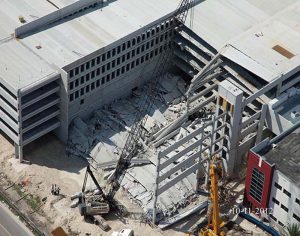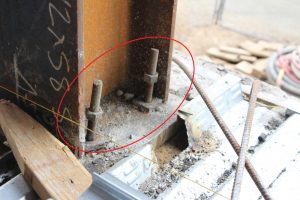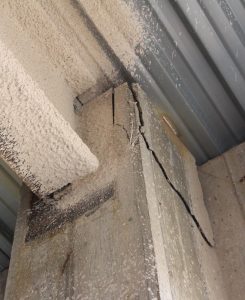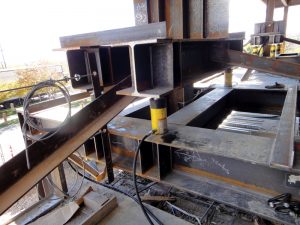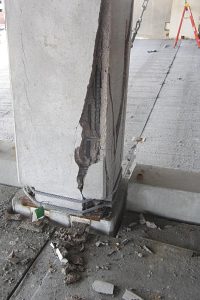Structural grouting is an integral part of precast concrete, steel, and tilt-up construction. Currently, there are no requirements in building codes or standards for the installation or special inspection of grouted joints. The lack of attention to the timeliness of structural grouting has led to structural failures in both precast concrete and steel-framed structures.
On October 10, 2012, a six-story precast parking structure in Miami, Florida, was under construction when a portion of the garage collapsed. The collapse killed four and injured three others. The collapse was caused, as reported by the Occupational Safety and Health Administration (OSHA) Construction Incidents Investigation Engineering Report, “because grout was not placed, as required, at the base of an interior column to adequately transfer the column load to the footing. As loads on the column gradually increased on the day of the incident, the bearing of the column over the shim plates exceeded its capacity, resulting in failure. This triggered a cascade of collapse of columns, inverted tee beams, and double tees on all five floors weighing approximately 3,300 tons over an area of approximately 16,000 square feet.” (Figure 1)
On September 3, 2015, a steel-framed structure in Colorado experienced failure because the grout was not placed before significant loads were placed on the structure. A steel column was supported with a steel shim stack on top of a concrete pilaster. The column supported four stories of structural steel framing, and a concrete slab on metal deck had been placed at levels two and three. The concentrated load on the shim stack caused it to punch into the top of the concrete pilaster, resulting in the failure of the concrete and a two-inch drop of the structural frame (Figures 2 and 3). The structure did not collapse but did require extensive repair to lift the building frame to the proper position (Figure 4) and to repair the fractured concrete.
Another instance of structural failure due to lack of timely grouting occurred on a precast concrete structure in Colorado. The precast column had not been grouted when a significant load was placed on it. The result was the shim stack punching into the precast column and causing a localized failure of the column (Figure 5).
These are only a few of the many failures that occur every year due to a lack of timely installation of structural grout or a lack of quality of grout installation. It is clear from these failures that structural grouting is often not given much consideration by specifiers, the timing of grout installation is often not adequately considered by contractors, and the installation is often performed by personnel not explicitly trained to install grout. Grouting is not necessarily a simple process: there are many limitations. Typical limitations include:
- Water Requirements – Precise measurements are required for drypack, flowable, and fluid mixtures
- Mixing Time – Typically between three and five minutes depending on the manufacturer
- Surface Preparation – Substrate temperature must be between 45°F and 90°F prior to grouting.
- Grout Temperature – Some manufacturers recommend that grout should be within 15°F of substrate temperature. Cure grout between 45°F and 90°F for a minimum of 24 hours.
- Supplemental Materials – Must add pea gravel for wider joints (over three inches for most manufacturers.)
It can also be challenging to install grout properly. Obtaining adequate compaction of drypack grout is difficult, especially with narrow joints, deep joints, or limited access. Fluid grout can be equally challenging with required formwork and the difficulty of avoiding trapped air, which prevents solid contact of grout with the bearing surface.
To address the gap in building codes and standards, the Structural Engineer’s Association of Colorado (SEAC) Precast Concrete Committee has developed recommended structural grouting practices. This committee consists of representatives of consulting engineering firms; precasters (precast manufacturers, precast specialty engineers, and precast erectors) in Colorado; and the Executive Director of the Precast/Prestressed Concrete Institute (PCI) Mountain States Region. The committee has developed the following suggested practices for the local market to improve the construction practices of structural grouting:
- Caution should be exercised when specifying grouting requirements in contract drawings. Language such as “100 percent grouted” or “fully grouted” may result in an effort that is not required by the design or may not meet the grouted joint detailing requirements. It is recommended that “grout as needed for design” or similar language be used to allow the precaster to define grouting requirements.
- Include the following items in specifications for precast projects along with a variant for other trades utilizing grouted joints
- Submittal of the Grouting QA/QC program that includes the following:
a. Temperature of substrates at time of placement and during the curing process as required by the manufacturer
b. Grout material technical data sheet
c. Placement procedure
d. Placement verification procedure - Precast installation by a PCI Certified Erector
- Submission of the precaster’s quality monitoring reports to the owner or design team as requested
Precasters should be responsible for establishing the QA/QC program, including grout design, installation requirements, and verification procedures. Each of these steps has an important role in establishing the necessary assurance and documentation as part of a close-out package to the design team and, ultimately, the building owner.
Colorado precasters and PCI have implemented several strategies to improve the quality of structural grouting. Colorado precasters have refined their QA/QC programs to ensure grouting is compliant with erection stability plans. Nationally, the PCI Field Safety Task Group recommended that all PCI Certified Erectors include, as part of the erector’s daily field reports, documentation that identifies each grouted joint and grout sleeve, the date it was completed, and its location in the building. The PCI Erectors committee is also developing grouting recommendations and is working on language to be included in the next edition of the PCI Erectors Safety Manual and the PCI Erectors Manual. It is expected that the recommendations will be similar to those presented above.
Special inspection may be utilized to verify the QA/QC programs are being executed as submitted and approved; however, the International Building Code (IBC) has no special inspection requirements for grouting. If the designer or owner request special inspection services, then the special inspection requirements should be fully defined by the party requiring the special inspection, including activity, frequency, and location.
The SEAC Precast Concrete Committee recommends additional review and attention be given to grouting requirements of all structural systems to ensure that a proper load path exists during construction and at ultimate loading.
To aid in the application of these recommendations, the SEAC Precast Committee has developed a guide, Structural Grouting Specification, Section 036000. This specification includes requirements for structural grouting of precast concrete joints, steel bearing assemblies, and tilt-up concrete joints. The specification is written with two separate paths for approval of the grouting procedures: performance-based and prescriptive.
The performance-based path is required to be used by PCI certified precast erectors and can also be used by experienced contractors. When the performance-based path is used, submittal of a comprehensive Installation and Quality Control Plan is required. This plan should include the following for each type of grouted joint: preparation and installation procedures, methods of thermal control and curing, method of verification of the quality of grouting, size of shim stacks, timing and sequence of grouting, and qualifications of personnel performing grouting operations.
The prescriptive path of the structural grouting specification is required when an Installation and Quality Control Plan is not submitted. The specification discusses the timing of grout placement to require grouting before large loads are imposed on the joint, preparation of the joint, required formwork, grout mixing, grout placement for dry-packed grout, poured grout, and pumped grout, as well as curing and finishing of grouted joints.
The specification also requires special inspection of grouted structural joints. For structures erected by PCI certified erectors, special inspections are recommended to inspect the work procedure for compliance with submitted Installation and Quality Control Plan. For other systems, special inspections should include a review of the preparation of joints to be grouted, mixing of grout in conformance with manufacturer instructions, the temperature of the air, substrate, and grout, placement of grout and grouting method, curing procedures, and test poured and pumped grout flow rates. Where the placement of concrete slabs, soil, or other construction may conceal joints, joints should be inspected before concealment. Prior to placement of concrete slabs supported by a column or wall, inspections should verify that grouting has been completed below the column or wall.
The specification intentionally does not indicate the use of grout cube testing per ASTM C109, as the compressive strength of a 2-x2-x2-inch grout cube is not representative of the actual strength of a grouted joint. Most grouted joints have a dramatically different aspect ratio and confinement than a 2-inch cube, which significantly increases the grout’s apparent strength. Also, ASTM C109 does not directly apply to pumped or fluid grouts. As such, while testing does indicate the performance of the material relative to the manufacturer’s stated test data and properties, it is not a good representation of in-situ grout strength. Better testing includes destructive testing to confirm the completeness of grout installation and other verification procedures during mixing and placing. The sample Structural Grouting Specification can be reviewed at https://bit.ly/2KymIxK. The SEAC Precast Concrete Committee recommends that practicing engineers, precasters, and contractors remain attentive to structural grouting and review and adapt the sample grouting specification as they see fit. Structural grout is an integral part of the structural system of nearly all structures; improper installation of this material can lead to failures.■

